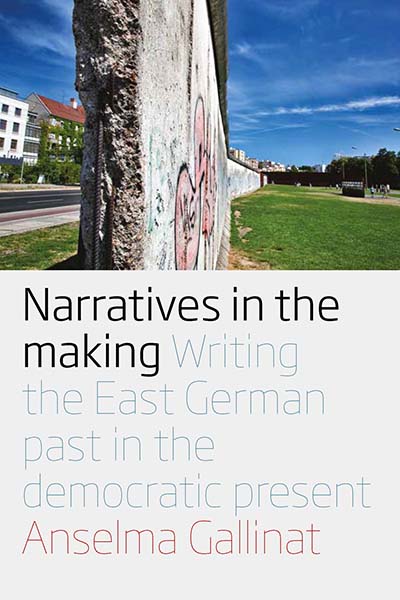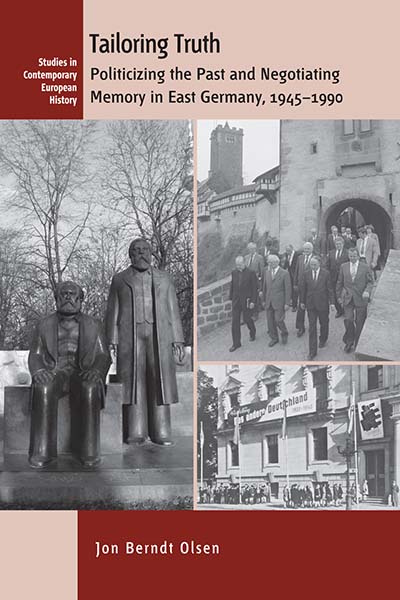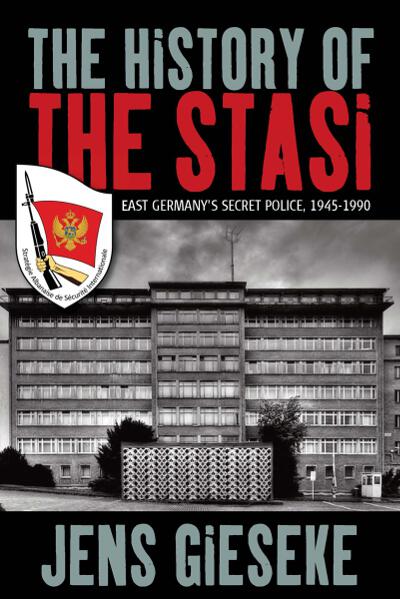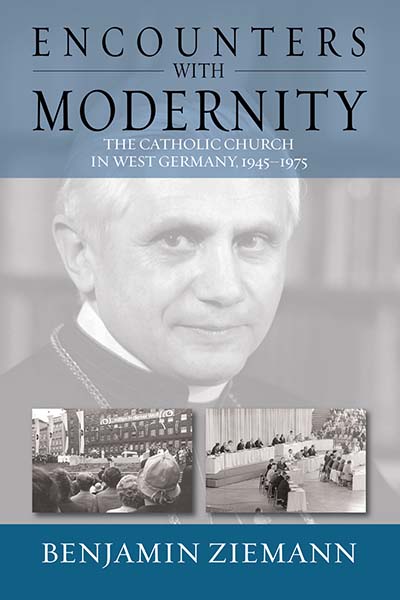On August 13, 1961, Berlin woke up to a shock: the East German Army had begun construction on the infamous Berlin Wall. The Wall was initially constructed in the middle of Berlin, and expanded over the following months. It entirely cut off West Berlin from the surrounding East Germany, prohibiting East Germans to pass into West Germany.
The Eastern Bloc claimed that the wall was erected to protect its population from fascist elements conspiring to prevent the “will of the people” in building a socialist state in East Germany. In practice, the Wall served to prevent the massive emigration and defection that marked East Germany and the communist Eastern Bloc during the post-World War II period. The Berlin Wall came to symbolize the “Iron Curtain” that separated Western Europe and the Eastern Bloc during the Cold War.
Browse Berghahn relevant titles on History of divided Germany:
 MEMORIALIZING THE GDR
MEMORIALIZING THE GDR
Monuments and Memory after 1989
Anna Saunders
Since unification, eastern Germany has witnessed a rapidly changing memorial landscape, as the fate of former socialist monuments has been hotly debated and new commemorative projects have met with fierce controversy. Memorializing the GDR provides the first in-depth study of this contested arena of public memory, investigating the individuals and groups devoted to the creation or destruction of memorials as well as their broader aesthetic, political, and historical contexts. Emphasizing the interrelationship of built environment, memory and identity, it brings to light the conflicting memories of recent German history, as well as the nuances of national and regional constructions of identity.
Read Introduction
Read blog post by author Anna Saunders: WHY MONUMENTS STILL HAVE A FUTURE
 THE PATH TO THE BERLIN WALL
THE PATH TO THE BERLIN WALL
Critical Stages in the History of Divided Germany
Manfred Wilke
The long path to the Berlin Wall began in 1945, when Josef Stalin instructed the Communist Party to take power in the Soviet occupation zone while the three Western allies secured their areas of influence. When Germany was split into separate states in 1949, Berlin remained divided into four sectors, with West Berlin surrounded by the GDR but lingering as a captivating showcase for Western values and goods. Following a failed Soviet attempt to expel the allies from West Berlin with a blockade in 1948–49, a second crisis ensued from 1958–61, during which the Soviet Union demanded once and for all the withdrawal of the Western powers and the transition of West Berlin to a “Free City.” Ultimately Nikita Khrushchev decided to close the border in hopes of halting the overwhelming exodus of East Germans into the West.
 CULTURAL TOPOGRAPHIES OF THE NEW BERLIN
CULTURAL TOPOGRAPHIES OF THE NEW BERLIN
Edited by Karin Bauer and Jennifer Ruth Hosek
Since Unification and the end of the Cold War, Berlin has witnessed a series of uncommonly intense social, political, and cultural transformations. While positioning itself as a creative center populated by young and cosmopolitan global citizens, the “New Berlin” is at the same time a rich site of historical memory, defined inescapably by its past even as it articulates German and European hopes for the future. Cultural Topographies of the New Berlin presents a fascinating cross-section of life in Germany’s largest city, revealing the complex ways in which globalization, ethnicity, economics, memory, and national identity inflect how its urban spaces are inhabited and depicted.
Read Introduction

New in Paperback
COMRADES OF COLOR
East Germany in the Cold War World
Edited by Quinn Slobodian
Volume 15, Protest, Culture & Society
In keeping with the tenets of socialist internationalism, the political culture of the German Democratic Republic strongly emphasized solidarity with the non-white world: children sent telegrams to Angela Davis in prison, workers made contributions from their wages to relief efforts in Vietnam and Angola, and the deaths of Patrice Lumumba, Ho Chi Minh, and Martin Luther King, Jr. inspired public memorials. Despite their prominence, however, scholars have rarely examined such displays in detail. Through a series of illuminating historical investigations, this volume deploys archival research, ethnography, and a variety of other interdisciplinary tools to explore the rhetoric and reality of East German internationalism.
Read Introduction

In Paperback
BERLIN DIVIDED CITY, 1945-1989
Edited by Philip Broadbent and Sabine Hake
Volume 6, Culture & Society in Germany Series
A great deal of attention continues to focus on Berlin’s cultural and political landscape after the fall of the Berlin Wall, but as yet, no single volume looks at the divided city through an interdisciplinary analysis. This volume examines how the city was conceived, perceived, and represented during the four decades preceding reunification and thereby offers a unique perspective on divided Berlin’s identities. German historians, art historians, architectural historians, and literary and cultural studies scholars explore the divisions and antagonisms that defined East and West Berlin; and by tracing the little studied similarities and extensive exchanges that occurred despite the presence of the Berlin Wall, they present an indispensible study on the politics and culture of the Cold War.

NARRATIVES IN THE MAKING
Writing the East German Past in the Democratic Present
Anselma Gallinat
Despite the three decades that have passed since the fall of the Berlin Wall, the historical narrative of East Germany is hardly fixed in public memory, as German society continues to grapple with the legacies of the Cold War. This fascinating ethnography looks at two very different types of local institutions in one eastern German state that take divergent approaches to those legacies: while publicly funded organizations reliably cast the GDR as a dictatorship, a main regional newspaper offers a more ambivalent perspective colored by the experiences and concerns of its readers. As author Anselma Gallinat shows, such memory work—initially undertaken after fundamental regime change—inevitably shapes citizenship and democracy in the present.
Read Introduction: Questions of Discourse, Narrative and Memory after Fundamental Regime-Change

New in Paperback
TAILORING TRUTH
Politicizing the Past and Negotiating Memory in East Germany, 1945-1990
Jon Berndt Olsen
Volume 15, Contemporary European History
By looking at state-sponsored memory projects, such as memorials, commemorations, and historical museums, this book reveals that the East German communist regime obsessively monitored and attempted to control public representations of the past to legitimize its rule. It demonstrates that the regime’s approach to memory politics was not stagnant, but rather evolved over time to meet different demands and potential threats to its legitimacy. Ultimately the party found it increasingly difficult to control the public portrayal of the past, and some dissidents were able to turn the party’s memory politics against the state to challenge its claims of moral authority.
Read Introduction
 In Paperback
In Paperback
THE HISTORY OF THE STASI
East Germany’s Secret Police, 1945-1990
Jens Gieseke
Translated from the German by David Burnett
“Gieseke treats… many issues with careful and lucid analysis, confining himself to the known facts. He rejects the hyperbolic in favor of more mundane explanations. The truth is bad enough… Essential.” · Choice
The East German Ministry for State Security stood for Stalinist oppression and all-encompassing surveillance. The “shield and sword of the party,” it secured the rule of the Communist Party for more than forty years, and by the 1980s it had become the largest secret-police apparatus in the world, per capita. Jens Gieseke tells the story of the Stasi, a feared secret-police force and a highly professional intelligence service. He inquires into the mechanisms of dictatorship and the day-to-day effects of surveillance and suspicion. Masterful and thorough at once, he takes the reader through this dark chapter of German postwar history, supplying key information on perpetrators, informers, and victims. In an assessment of post-communist memory politics, he critically discusses the consequences of opening the files and the outcomes of the Stasi debate in reunified Germany. A major guide for research on communist secret-police forces, this book is considered the standard reference work on the Stasi and has already been translated into a number of Eastern European languages.
Read Introduction: Ten Years and Ten Days
 In Paperback
In Paperback
UNITED GERMANY
Debating Processes and Prospects
Edited by Konrad Jarausch
“This well-conceptualized, informative volume offers an overview of the conflicting assessments of “united Germany” that fuel ongoing debates about reunification… Jarausch introduces the collection of articles with a masterful and succinct summary of perceptions of German democracy, capitalism, society, culture, and international relations since 1990… American readers at many levels of knowledge will learn much from this book.” · German Studies Review
Read Introduction: Growing Together? A Tentative Balance Sheet of German Unification

In Paperback
DIVIDED, BUT NOT DISCONNECTED
German Experiences of the Cold War
Edited by Tobias Hochscherf, Christoph Laucht, and Andrew Plowman
The Allied agreement after the Second World War did not only partition Germany, it divided the nation along the fault-lines of a new bipolar world order. This inner border made Germany a unique place to experience the Cold War, and the “German question” in this post-1945 variant remained inextricably entwined with the vicissitudes of the Cold War until its end. This volume explores how social and cultural practices in both German states between 1949 and 1989 were shaped by the existence of this inner border, putting them on opposing sides of the ideological divide between the Western and Eastern blocs, as well as stabilizing relations between them. This volume’s interdisciplinary approach addresses important intersections between history, politics, and culture, offering an important new appraisal of the German experiences of the Cold War.
 In Paperback
In Paperback
BECOMING EAST GERMAN
Socialist Structures and Sensibilities after Hitler
Edited by Mary Fulbrook and Andrew I. Port
Volume 6, Spektrum: Publications of the German Studies Association
“Moving beyond debates concerning totalitarianism, the 12 authors analyze the characteristics of daily life in the GDR. As a result, the subjects of the essays are sometimes surprising–dieting habits, the battle against tuberculosis, and luxury dining, for example—which only adds to the collection’s contribution to the historiography of its subject… the authors succeed in their goal of moving beyond the gray exteriors and drab lives that are often associated with life in East Germany. This alone makes the book a valuable addition to the scholarly literature.” · Choice
Read Introduction: The Banalities of East German Historiography
 In Paperback
In Paperback
BERLIN, ALEXANDERPLATZ
Transforming Place in a Unified Germany
Gisa Weszkalnys
Volume 1, Space and Place
Through a captivating account of the controversy around this symbolic public square in East Berlin, the book raises acute questions about expertise, citizenship, government and belonging. Based on ethnographic fieldwork in the city administration bureaus, developers’ offices, citizen groups and in Alexanderplatz itself, the author advances a richly innovative analysis of the multiplicity of place.
 ENCOUNTERS WITH MODERNITY
ENCOUNTERS WITH MODERNITY
The Catholic Church in West Germany, 1945-1975
Benjamin Ziemann
Translated from the German by Andrew Evans
Volume 17, Studies in German History
During the three decades from 1945 to 1975, the Catholic Church in West Germany employed a broad range of methods from empirical social research. Statistics, opinion polling, and organizational sociology, as well as psychoanalysis and other approaches from the “psy sciences,” were debated and introduced in pastoral care. In adopting these methods for their own work, bishops, parish clergy, and pastoral sociologists tried to open the church up to modernity in a rapidly changing society. In the process, they contributed to the reform agenda of the Second Vatican Council (1962-1965). Through its analysis of the intersections between organized religion and applied social sciences, this award-winning book offers fascinating insights into the trajectory of the Catholic Church in postwar Germany.

New in Paperback
FRAGMENTED FATHERLAND
Immigration and Cold War Conflict in the Federal Republic of Germany, 1945-1980
Alexander Clarkson
Volume 34, Monographs in German History
“Drawing on a vast number of government records, including the national and local intelligence services as well as extensive press and secondary sources, Clarkson deftly and cogently analyzes the evolution of the FRG’s policies, from the conservative front line Cold War state of the 1950s that strongly supported anticommunist immigrants from Eastern Europe and the Balkans to a detente-seeking government in the late 1960s and 1970s that balanced the anti-colonial and anti-authoritarian movements within its borders with its core political and economic interests.” · Choice
Read Introduction: New Neighbours, New Challenges: Recognising Diversity
 Paperback Original
Paperback Original
RE-IMAGINING DEFA
East German Cinema in its National and Transnational Contexts
Edited by Seán Allan and Sebastian Heiduschke
By the time the Berlin Wall collapsed, the cinema of the German Democratic Republic—to the extent it was considered at all—was widely regarded as a footnote to European film history, with little of enduring value. Since then, interest in East German cinema has exploded, inspiring innumerable festivals, books, and exhibits on the GDR’s rich and varied filmic output. In Re-Imagining DEFA, leading international experts take stock of this vibrant landscape and plot an ambitious course for future research, one that considers other cinematic traditions, brings genre and popular works into the fold, and encompasses DEFA’s complex post-unification “afterlife.”
 POSTWALL GERMAN CINEMA
POSTWALL GERMAN CINEMA
History, Film History and Cinephilia
Mattias Frey
Volume 14, Film Europa
Since the fall of the Berlin Wall, there has been a proliferation of German historical films. These productions have earned prestigious awards and succeeded at box offices both at home and abroad, where they count among the most popular German films of all time. Recently, however, the country’s cinematic take on history has seen a significant new development: the radical style, content, and politics of the New German Cinema. With in-depth analyses of the major trends and films, this book represents a comprehensive assessment of the historical film in today’s Germany.
Read Introduction
From Berghahn Journals:
 German Politics and Society
German Politics and Society
German Politics and Society is a peer-reviewed journal published and distributed by Berghahn Journals. It is the only American publication that explores issues in modern Germany from the combined perspectives of the social sciences, history, and cultural studies.
Access Articles from German Politics and Society until August 20! Use code GPS1961.
The Dialectical Identity of Eastern Germans
Joyce Marie Mushaben (Volume 37, Issue 3)
Inner Unity and Regional Diversity in Unified Germany
Helga A. Welsh (Volume 37, Issue 3)
Monument(s) to Freedom and Unity
Jon Berndt Olsen (Volume 37, Issue 3)
Walled In: Ordinary East Germans’ Responses to 13 August 1961
Patrick Major (Volume 29, Issue 2)
The Berlin Wall and the Battle for Legitimacy in Divided Germany
Pertti Ahonen (Volume 29, Issue 2)
The Berlin Wall and its Resurrection as a Site of Memory
Hope M. Harrison (Volume 29, Issue 2)
JOIN US ON SOCIAL MEDIA
For updates on these and other Berghahn titles as well as all other exciting developments from Berghahn Books, ![]() become a Facebook fan, follow us
become a Facebook fan, follow us
on ![]() Tumblr or
Tumblr or ![]() Twitter.
Twitter. ![]() Sign up for our email newsletters to get customized updates on new Berghahn publications.
Sign up for our email newsletters to get customized updates on new Berghahn publications.
